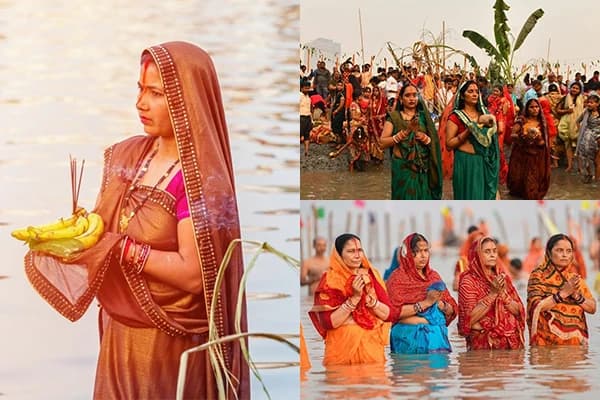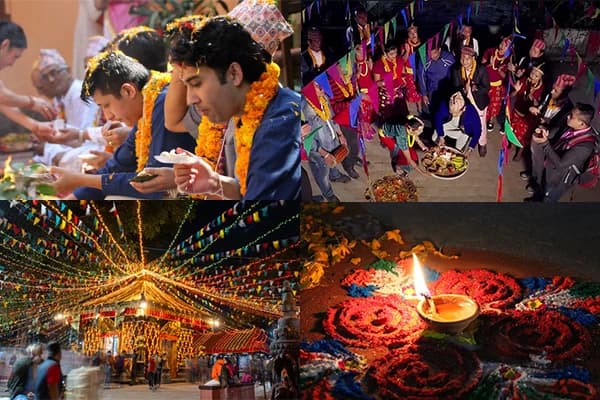Main Rituals and Traditions of the Day
The main ritual of the day is the tika and jamara ceremony. In this ceremony, the elders of the family apply tika on the foreheads of the younger members. Along with the tika, a jamara is also placed behind the ears or on the head.
The tika is basically a mixture of red vermillion, yogurt, and rice. The color red because it is a symbol of power, purity, and love. While the jamara is a yellow-green barley sprout grown since the first day of Dashain.
This ritual is considered auspicious and symbolizes the transfer of blessings, power, strength, wisdom, and prosperity from the older generations to the younger. While for the younger generations, receiving a tika is a mark of respect, protection, and familial love.
- Dakshina (Gifts of Money and Respect)
Dakshina is an important part too. After applying the tika and jamara, elders give a dakshina to the younger generations as a symbol of gratitude, respect, and blessings. The dakshina can be anything, like money or small gifts.
This part of the event is often loved by the younger generations as they receive gifts or money from their elders. The younger generations in return express gratitude and commitment to family values.
- Visiting Elders and Relatives
After finishing the tika ceremony in the home, the family members now visit their elders and relatives who are far from their homes. It has been a central tradition on the Bijaya Dashami and the days following during the Dashain festival.
The visits reinforce the family bonds and community ties. Families spend the entire day moving from house to house, visiting grandparents, uncles, aunts, and other respected elders to take part in the tika jamara ceremony. These visits are accompanied by the traditional meals, festive gatherings, and joyful interactions.
- Blessings and Social Harmony
Bijaya Dashami Blessings play a central role in fostering social harmony and family unity during the Dashain festival. The act of blessings is deeply spiritual and is accompanied by the Sanskrit mantras invoking strength, wisdom, and auspiciousness.
Families from a distance gather in one place to receive these blessings. The bonds get strengthened and create a profound sense of respect and unity across the generations.
The ritual is not limited to blood relatives—neighbors, community leaders, and even distant acquaintances are included. This creates a strong sense of social solidarity and cultural continuity.
- Symbolic Practices of the Day
On this special day of Bijaya Dashami, new clothes are worn, and homes are decorated, cleaned, and filled with festive energy. While not common now, in the past days, kites were flown in the skies, and swinging on the bamboo swings was practiced.
These practices of the day symbolized the freedom, joy, and ascent of the good energy. Some communities also combine the tika ceremony with cultural performances, music, and local gatherings.
Food and Festive Delights
Bijaya Dashami is incomplete without its grand feast. Food is not just about eating but about sharing abundance and joy.
- Traditional Bijaya Dashami Feast
The traditional Dashain feast is a grand and hearty celebration centerpiece in Nepal. It features an array of special dishes that emphasizes meat, rice, and festive sweets.
The main component of the traditional Bijaya Dashami feasts includes mutton curry, mutton sekuwa and pakku, chhoila, sel roti, fried fish, daal, bhaat tarkari, chatni, and achhar.
The main part of the feast is meat, which is prepared after slaughtering goats (and sometimes buffalo). It is an age-old tradition tied to offerings made to Goddess Durga.
- Special Sweets and Treats
There is a special place for sweets and treats in the Bijaya Dashami feasts. These sweets and treats add sweetness and joy to the Dashain festival atmosphere. These sweets are shared among family members and friends.
The popular sweets during the Bijaya Dashami include barfi, lal mohan, lakhamari, shrikhand, rabri, rasmalai, khajurri, rasgulla, and kalakhand.
- Drinks and Festive Beverages
Along with the traditional Bijaya Dashami feasts, the drinks and festive beverages are also consumed. These beverages add extra joy to the festive atmosphere.
The traditional festive drinks that are consumed on the Bijaya Dashami day are chhyang, raksi, tonggba, lassi, Nepali masala tea, soft drinks like Sprite, cola, and Fanta, and other homemade juices or sherbets.
- Sharing Food as a Cultural Symbol
During the Bijaya Dashami, sharing foods and drinks is considered an auspicious tradition. It is a profound cultural and spiritual practice that strengthens family bonds, promotes social harmony, and reflects the Nepalese value of respect and generosity.
Food is prepared in large quantities since extended families and visitors keep arriving throughout the day.
Modern Adaptations of Bijaya Dashami
The main day of the day, Bijaya dashami celebrations has seen several modern adaptations while retaining its core traditional and spiritual significance.
The rituals in the urban area have been simplified. The busy and urbanized lifestyles have led people to shorten or simplify the rituals. The symbolism offerings lie fruits and vegetables are increasingly used in place of actual sacrifices.
The key ingredients of the tika and jamara are brought from the market instead of growing and making it in homes. Online shopping for clothes,gifts and festival items have become common.
With many Nepalis living abroad, the virtual blessings through video calls during the bijaya dashami are now the new routine.
If you’re in Nepal during Dashain, experiencing Bijaya Dashami firsthand is a memory of a lifetime.





